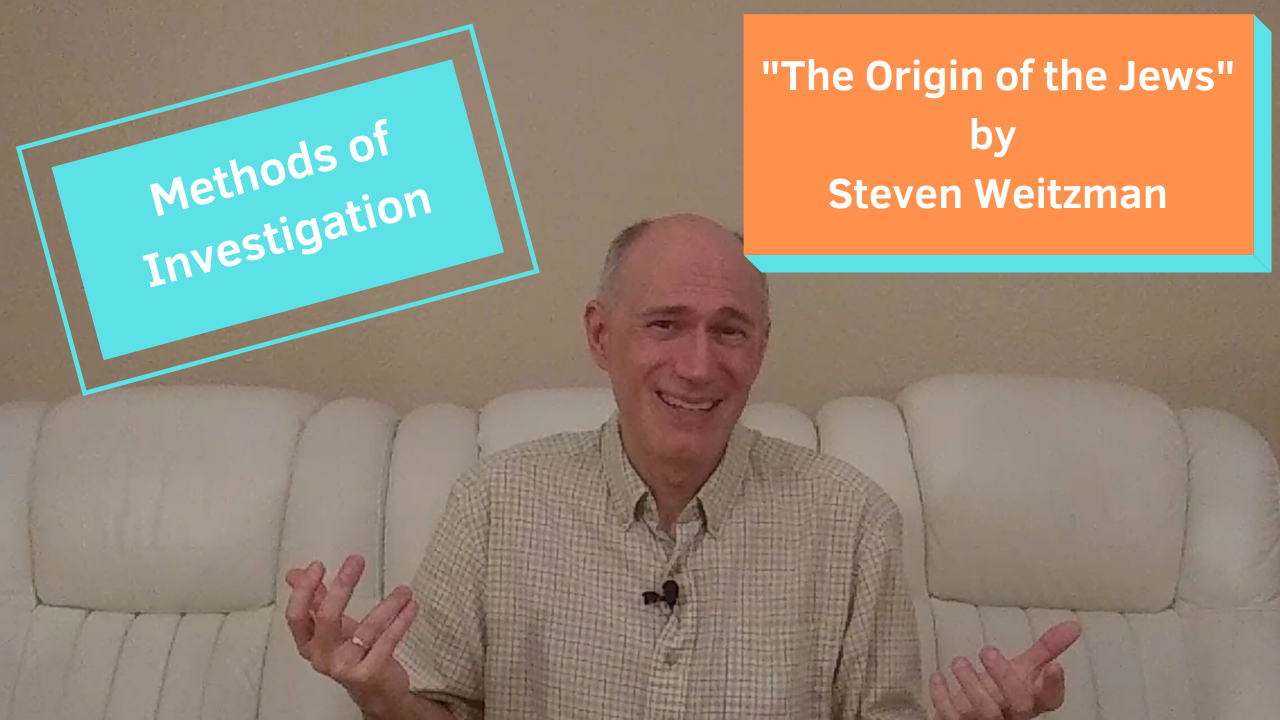02/10/2021 – The Origin of the Jews

Is it possible to determine the origin of the Jews? Let’s look at one scholar who uses multiple methods and see what he discovered. This is TenOnReligion.
Hey peeps, it’s Dr. B. with TenOnReligion. Steven Weitzman is a Professor at the University of Pennsylvania and an expert on Jewish history and languages. His 2017 book titled The Origin of the Jews employs eight methods in an attempt to find the origin of the Jews as a population group. The title is a little bit misleading because I thought this author actually answers this question in the book, but he doesn’t. The book is more about how one’s choice of investigative method affects both how one answers the question and also to what extent the question is answerable, if that makes any sense.
Right off the bat in the introduction Weitzman rightly highlights two important questions. First, what does one mean by “the Jews” and what does one mean by “origin?” Are the Jews to be understood as people united by common lineage, or common community constituted through sharing religious experiences such as similar beliefs and practices? If it’s common lineage, then the goal is to try to identify the ancestors. If it’s a common faith community, then the goal is to try to find origin of the beliefs and practices. The second issue is what does one mean by “origin?” By the “origin of the Jews” do we mean how Jews developed out of what preceded them, or the process that distinguished them from that which existed before? The starting point is always an interpretive decision based on at what point something becomes different.
Politics also clearly play a role here because, for some people, the search for the origin of the Jews has a direct relation to the modern nation state of Israel. In pre-Enlightenment times the Jews were treated as a separate population in Europe. There were and are competing claims about the geographic origin of the Jews and their relationship to the ancient inhabitants of Judea. Were Jews’ ancestors there first or were Palestine’s ancestors there first? The question is no longer how Jews fit into Europe, but how the Jewish state and Palestinians fit into the global post-WWII political order. There is the influence of the late 20th century recognition that indigenous communities have rights that need to be recognized, although there is ambiguity regarding what the term “indigenous” amounts to. The problem is that since Jews were not present in the land at the time of its colonization, they are the ones accused of being the European colonizers. Strange twist. Lastly, there is a distinction between “origin” and “beginning” which Weitzman cites from Edward Said’s book Beginnings: Intention and Method from 1975. “Origin” as deriving reality from a foundational moment, figure, or inaugural state vs. “beginning” as meaning there is no one way to begin. A work of fiction like a novel can start the story anywhere it wants such that the beginning is self-determining. Interesting? Enough intro, here are the methods he covers:
- Genealogy
- Etymology
- History
- Archeology
- Psychoanalysis
- Hybridity
- Invention story
- Genetics
One quick caveat – I didn’t fully get the psychoanalysis chapter based on Freud, so I’m going to skip over that one, so if want info on that you’re going have to get the book. Sorry!
Ok, let’s dive into these methods.
One, genealogy. Genealogists can trace back royal families back to the Middle Ages – even to Charlemagne from the year 800, but not back to ancient times like early Judaism. One cannot simply use textual sources such as the Bible because there is evidence of genealogical tampering in the text, largely for political reasons. One example was changing the name of an ancestor of a corrupt priest from Moses to another name so Moses’ persona wouldn’t be tarnished. There are clearly biological and subjective aspects to using this as a method. He ultimately describes three methods: more traditional genealogy, a constructivist method whereby shared identities of a people group construct narratives to make ancestors regardless of whether or not such ancestors are real people or imaginary, and third, a postmodern approach which criticizes the search for origin itself as even a thing that is possible.
Two, etymology – the search for the source of specific words, in this case “Hebrew” and “Israel.” The use of the word “Hebrew” appears earlier than “Israel,” which I found interesting. The author then talks a lot about this word “Habiru” which appears thousands of years ago, but disappears after the 11th century BCE, right about the same time the first datable reference to the term “Israel” appears in 1207 BCE. Now here’s where things get tricky. The relationship, if any, between the earlier term “Habiru” and the later term “Hebrew” is unknown. The Habiru are often described as bandits and fugitives, and if connected to Hebrews as their ancestors, this means they were not migrants from Mesopotamia like Abraham or Egyptian ex-slaves like Moses, but early Canaanite vagabonds and rebels coming from the margins of Late Bronze Age society. They were not outsiders to the Canaanites who were already living in the land. But drawing from the French philosopher’s Saussure’s work on linguistics, a word’s meaning is generated based on its relationship to other words within the same language. This means one must study the rules and usage of a language at a specific point in time. Thus, a semantic gap opens up between what we think “Habiru” and “Hebrew” might mean to us today and how those terms were used back then. Get it?
Three, history. In the past few hundred years, modern scholarship has created this arbitrary dividing line in history between the biblical Israelites and the postbiblical Jews. What’s known as the Persian period, ending in the 300’s BCE or so was the line. The effort to distinguish early Hebrews and later Jews was part of a long tradition of Christian anti-Jewish arguments that sought to discredit the Jews as authentic heirs to biblical Israel, but what added a new dimension to it in modern times was the emergence of developmentalist thinking as a way to account for the difference between Israelites and Jews. Weitzman then dives into the documentary hypothesis formed by the German scholar Wellhausen. I won’t go into all of the details of that here, but basically the idea was that Judaism’s development was not dependent on foreigners, but on an internally driven evolutionary process. But over time Wellhausen’s theory was criticized. The assigning of sources to specific eras became problematic for a variety of reasons. When one cannot assign specific sources to specific periods, or to place them in chronological order, the source criticism like Wellhausen’s documentary hypothesis loses its value as a way of supporting developmental narratives of how ancient Israelite religion gave rise to Judaism. One response to this became known as minimalism which arose in the 1980’s in Europe – basically the ancient narratives were all made up – but later archeological discoveries has made that approach problematic. The overall issue is that today most scholars no longer think in terms of developmental frameworks.
Four, archeology. This chapter’s main theme is ethnogenesis, the process by which a distinct ethnic group emerges with a common consciousness of belonging. Here, Weitzman focuses on one archeological site, Beth Shemesh, providing detail of excavations in three separate expeditions from the 1910’s to the 1950’s, noting the differences in the conclusions of each. These created a trend, moving away from evolutionary explanations of Israelite origins. There is a large scholarly consensus that the ancient Israelites emerged out of earlier Canaanite culture, but it’s still unclear exactly when and how.
Five, psychoanalysis. Freud. Yeah, like I said, we’re skipping this one.
Six, hybridity. During the Hellenistic period of Greece, spawned from Alexander the Great’s conquests in the 300’s BCE, many non-Greek populations adopted the Greek way of life such as language and cultural forms. This was called Hellenism. This chapter asks if the Jews became Jewish through a similar process. The word “Judaism” appearing for the first time in the second century BCE, is an example of this fusion of Judean and Greek culture. The word “Judaism” is a hybrid word, merging the Greek spelling of Yehuda (Judah) with the Greek suffix -ismos, which was used in words like medismos (from the name “Media,” a part of Persia, and referring to the act of aligning oneself with the Persians) or hellenismos (from “Hellene,” and referring to the act of following a Greek way of life). Like these other words, iudaismos or Judaism, probably referred to a Judean way of life or the act of aligning oneself with the Judeans. Its first known appearance is in 2 Maccabees 4:13, a text written in Greek as an account of the Maccabean Revolt, and there it is placed in contrast to the word hellenismos in a way that suggests that the Judean and Greek ways of life were opposite each other. Ancient Greek identity as described by the ancient Greek historian Herodotus, was originally based on four factors: blood, language, worship, and way of life. The first, blood, one is born with, but the last three can be acquired. This line of thinking passed into the Jews transforming Judean identity into Jewishness.
Seven, invention story. He uses the example of the Apple I computer invention story in a garage by Steve Jobs and Steve Wozniak. The story was largely made up to signify the identity of something arising out of nothing. Weitzman notes that we should attend more to what precedes the act of invention, the history of earlier industries and social relationships from which it originates. He contrasts constructivists from primordialists. Constructivists have a top-down approach to nationalism initiated by an intellectual and political elite who use writing, technology, education, and civic rituals to instill a sense of national consciousness in a population otherwise fragmented. For primordialists, nationalism feelings are not manufactured but arise from naturally occurring emotions, the same feelings of attachment that we feel for our immediate family members now extended to a particular locality. The temporal expression backward in time makes it feel primordial, like something established a long time ago.
Eight, genetics. This chapter gets into the scientific study of using DNA to track population groups throughout history. The author describes two sides to the coin: those who feel genetic research leads to some tentative conclusions and those who are skeptical of this approach. There’s actually a lot more going on in this chapter, but this video is getting a little too long.
For me, the best chapter was the one on history, but I also really liked how he set up the entire book in the introduction as well. The bottom line is there are many ways to investigate what the origin of a population group is, especially one with as long and complicated of a history as the Jews.
Next time we’re going to address the controversial question, is Confucianism a religion? Oooo. That’s it for today. I hope this vlog has helped you better understand this topic. Until next time, stay curious. If you enjoyed this, please like this video and subscribe to the channel. This is TenOnReligion.


